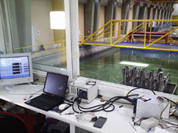EUROPEAN PROJECTS ➤ Fourth Framework Programme ➤ LabBuoy
Economically efficient floating device for wave power conversion into electricity; Phase I: Mathematical and physical model testing
| Project Duration | 01/01/2002 - 31/10/2003 |
| Total Budget | 800.884,00 € |
| Website | https://cordis.europa.eu/ |
Sea waving is an inexhaustible energy resource, like all forms of Renewable Energy Sources (RES). Among all RES sea waving presents the highest energy density. Although Europe (Greece included) poses exploitable wave energy resources and the respective research has started since the decade of 70’s, no method enabling industrial application has arisen up to date.
The present project was aiming at the theoretical and experimental testing of an innovative technology, patented in Greece, for converting sea-wave energy to electricity. The method utilizes a buoy following the reciprocal vertical motion of the sea mass, which is following converted into rotational motion of a generator, through a simple mechanism.

During the realization of the project the basic characteristics of the technology e.g. its dynamic behavior and the relevant effectivity, were investigated, theoretically as well as experimentally. A mathematical model of the technology was developed, with which the device behavior regarding the incident, random waving could be described.
Following, an experimental model, in 1:15 scale was constructed and measurements were taken in an artificial waving pool. Target of the experiments was the certification of the mathematical model.
The results of the project have been encouraging for the further development of the technology. The cost of power production it is presently estimated at 7–9 c€/kWh, i.e. much less than the respective cost of other wave energy technologies and it is estimated that it will become less as a result of technology maturing.
The project duration was 22 months and it was coordinated by the Water technologies department of the Centre of Renewable Energy Sources (CRES). Participants were as well the National Technical University of Athens (NTUA), the company Athena S.A., the company Ramboll (DK), the Polytechnic school of Queen’s University of Belfast (UK) and the Polytechnic school of the University of Cork (IE). The project was co-funded by the 5th Framework Program for Research and Technological Development of the European Commission.
